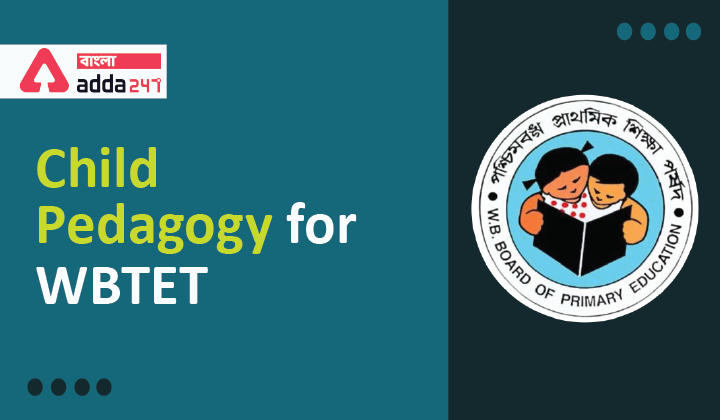Child Pedagogy MCQ (শিশু শিক্ষাবিদ্যা MCQ): Child Pedagogy MCQ is very important for WBTET exam. You get here daily Child Pedagogy MCQ. Everyday you get 10 Child Pedagogy Question & Solution. It is necessary for upcoming teaching exam.
Q1. নিচের কোনটির উন্নতির জন্য শিক্ষণের ব্রেইন স্টর্মিং মডেল ব্যবহার করা হয়?
(a) বোঝা
(b) অ্যাপ্লিকেশন
(c) সৃজনশীলতা
(d) সমস্যা সমাধান
Q2. গোলম্যান নিচের কোনটির সাথে যুক্ত?
(a) সামাজিক বুদ্ধিমত্তা
(b) আবেগগত বুদ্ধিমত্তা
(c) আধ্যাত্মিক বুদ্ধিমত্তা
(d) সাধারণ বুদ্ধিমত্তা
Q3. বিজোড়টি খুঁজে বের করুন.
(a) থিওরি অফ লার্নিং টু লার্ন
(b) থিওরি অফ আইডেন্টিক্যাল এলিমেন্ট
(c) ড্রাইভ রিডাকশন থিওরি
(d) থিওরি অফ জেনেরালাইজেশন
Q4. কগনিটিভ অ্যাচিভমেন্ট এর সর্বনিম্ন স্তর
(a) জ্ঞান
(b) বোঝা
(c) অ্যাপ্লিকেশন
(d) বিশ্লেষণ
Read More: পশ্চিমবঙ্গ পুলিশ কনস্টেবল রেজাল্ট 2021
Q5. একটা ছেলে যে সাইকেল চালাতে পারে সে মোটরবাইক চালাতে যাচ্ছে। এটি একটি উদাহরণ –
(a) শেখার অনুভূমিক স্থানান্তর
(b) শেখার উল্লম্ব স্থানান্তর
(c) শেখার দ্বিপাক্ষিক স্থানান্তর
(d) শেখার স্থানান্তর নেই
Q6. নিচের কোনটি শিক্ষার মালভূমির কারণ নয়?
(a) প্রেরণার সীমা
(b) বিদ্যালয়ের অসহযোগিতা
(c) শারীরবৃত্তীয় সীমা
(d) জ্ঞানের সীমা
Q7. “শিক্ষা হল অভিজ্ঞতা এবং প্রশিক্ষণের মাধ্যমে আচরণের পরিবর্তন।” এই বিবৃতি দিয়েছেন –
(a) গেটস এবং অন্যান্য
(b) মরগান এবং গিলিল্যান্ড
(c) স্কিনার
(d) ক্রনবাচ
Q8. ‘স্ট্যানফোর্ড – বিনেট টেস্ট’ ব্যবস্থা –
(a) ব্যক্তিত্ব
(b) পড়ার দক্ষতা
(c) বুদ্ধিমত্তা
(d) উপরের কোনটি নয়
Q9. অন্তর্মুখী ব্যক্তিত্ব এবং বহির্মুখী ব্যক্তিত্ব কে শ্রেণীবদ্ধ করেছেন?
(a) ফ্রয়েড
(b) জং
(c) মুন
(d) অলপোর্ট
Q10. শিশুদের সামাজিক বিকাশকে প্রভাবিত করার কারণগুলি হল-
(a) অর্থনৈতিক উপাদান
(b) সামাজিক – পরিবেশগত উপাদান
(c) ভৌত উপাদান
(d) বংশগত উপাদান
Also Check: WBCS Official Answer Key 2021 (WBCS অফিসিয়াল উত্তরপত্র 2021)
Child Pedagogy MCQ Solution
S1. Ans.(d)
Sol. Brainstorming combines a relaxed, informal approach to problem solving with lateral thinking. It encourages people to come up with thoughts and ideas that can, at first, seem a bit crazy. Some of these ideas can be crafted into original, creative solutions to a problem, while others can spark even more ideas.
S2. Ans.(b)
Sol. Daniel Goleman’s emotional intelligence theory outlines five components of EQ: self-awareness, self-regulation, motivation, empathy, and social skills. Emotional intelligence can be applied to meet goals and targets, as well as create a happier and healthier working culture.
S3. Ans.(c)
Sol. A theory of learning in which the goal of motivated behavior is a reduction of a drive state. It is assumed that all motivated behavior arises from drives, stemming from a disruption in homeostasis, and that responses that lead to reduction of those drives tend to be reinforced or strengthened.
S4. Ans.(a)
Sol. The cognitive domain involves six categories of learning that serve in the development of intellectual skills. The lowest level of cognitive achievement is knowledge.
S5. Ans.(b)
Sol. Acquisition of new responses contingent on the learning of prerequisite, subordinate capabilities. For example, experiences of driving scooter during Motorcycle driving, Hence it is clear that A boy who can ride a cycle is going to drive a motorbike. This is an example of a vertical transfer of learning.
S6. Ans.(b)
Sol. It refers to a time when the learner, regardless of their best efforts, seems to “stop” making visible progress. Much like when you start climbing a mountain. You’ll see rapid progress in the beginning stages of your climb. Non-cooperation of school is not a cause of learning plateau.
S7. Ans.(a)
Sol. The much prominent educational psychologist E.A. Gates described learning as a modification of an individual’s behavior through experience and training.
S8. Ans.(c)
Sol. The standard measure of intelligence since 1916, the Stanford-Binet documents the cognitive strengths and weaknesses of children, adolescents, and adults. Its 10 subtests assess five cognitive factors: Fluid Reasoning; Knowledge; Quantitative; Visual-Spatial; and Working Memory.
S9. Ans.(b)
Sol. In the 1960s, psychologist Carl Jung first described introverts and extraverts when discussing personality elements. (The term now commonly used is extroverts.) He classified these two groups based on where they found their source of energy.
S10. Ans.(b)
Sol. Some of the factors which have a bearing on the level of social development are the social-environmental elements: The social development of a child is regulated by the culture and society in which he/she lives. The school: A lot of school-related factors influence the socialization of the child.
- Read more :
Child Pedagogy প্রতিদিন ADDA 247 বাংলা 10 টি করে MCQ সহ Answers এবং Solution দিচ্ছে। WB TET, CTET পরীক্ষার জন্য Child Pedagogy অত্যন্ত গুরুত্বপূর্ণ। এছাড়া History, Geography, Physics, Chemistry, Biology, Economics, Polity এবং Daily Reasoning এর নতুন নতুন অনেক MCQ পরীক্ষার্থীদের সকল প্রতিযোগিতামূলক পরীক্ষায় সাফল্য আনতে সাহায্য করবে। প্রতিযোগিতামূলক উত্তীর্ণ হওয়ার চাবিকাঠি Mathematics এবং Reasoning। Daily Mathematics এবং Reasoning প্র্যাক্টিস যেকোনো পরীক্ষার্থীকে সাফল্যের দোরগোড়ায় পৌঁছে দেবে।
Watch More on YouTube:
Adda247 ইউটিউব চ্যানেল – Adda247 Youtube Channel
Adda247 টেলিগ্রাম চ্যানেল – Adda247 Telegram Channel





